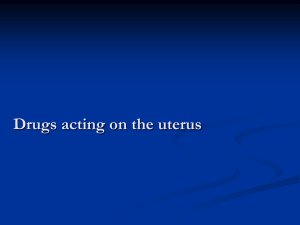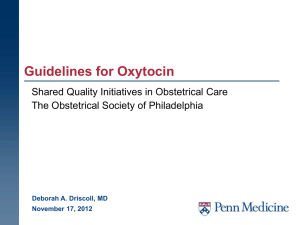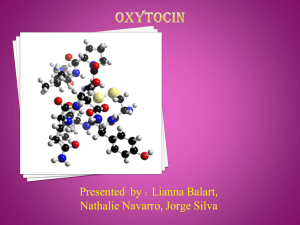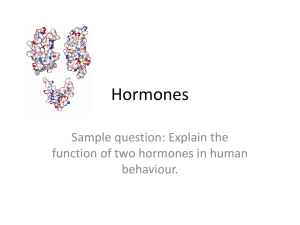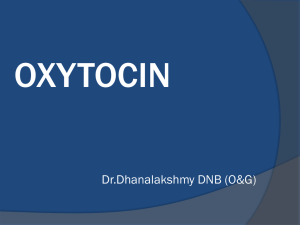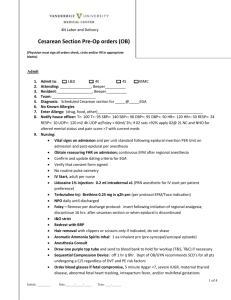Assessing Oxytocin Sufficiency
advertisement
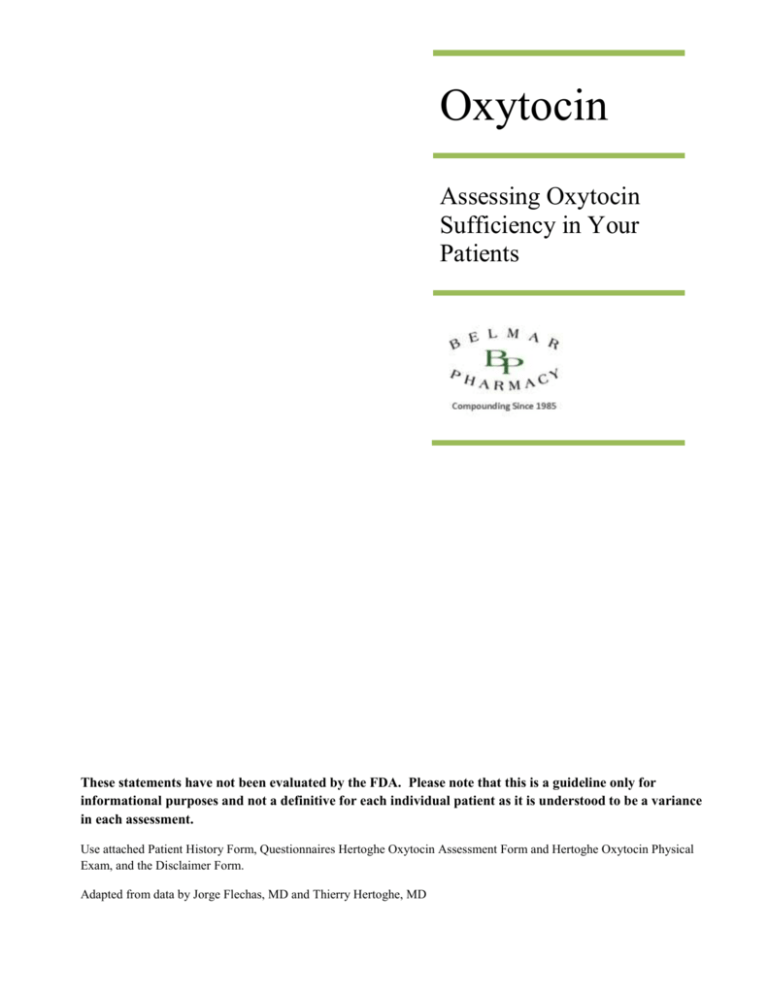
Oxytocin Assessing Oxytocin Sufficiency in Your Patients These statements have not been evaluated by the FDA. Please note that this is a guideline only for informational purposes and not a definitive for each individual patient as it is understood to be a variance in each assessment. Use attached Patient History Form, Questionnaires Hertoghe Oxytocin Assessment Form and Hertoghe Oxytocin Physical Exam, and the Disclaimer Form. Adapted from data by Jorge Flechas, MD and Thierry Hertoghe, MD Assessing Oxytocin Sufficiency in Your Patients For many years, clinicians have been aware that oxytocin sufficiency plays a critical role in labor and delivery, lactation, and autism; however, volumes of recent studies have shown that oxytocin also plays a key role in maintaining other aspects of overall health. Research confirms that adequate oxytocin is critical for normal cellular function in other organ systems. The Emerging Link Between Oxytocin Sufficiency and Disease Incidence A closer look at the mounting research studies revealed that low levels of oxytocin are associated with increased risk of certain medical conditions, including: Prader Willi Syndrome1-3 Autism4 Low Estrogen5 Low Thyroid T36 Depression7 AIDS8 CMV Infection15 Multiple Sclerosis9 Fibromyalgia10 Chronic Stress Situations11 Chronic Opioid Use12 Parkinsons12 Lonliness13 Anxiety Disorders14 Some types of Schizophrenia15 www.belmarpharmacy.com Anxiety Stress Depression Appetite Pain19 Increased odds of primary cesarean delivery Lack of lactation Oxytocin sufficiency protects against: Obesity Heart Disease Drug Addiction19 Oxytocin’s Classic Physiology Oxytocin deficiency has been linked to increased risk of developing: Autism Depression Fibromyalgia Oxytocin deficiency in pregnancy and after delivery is associated with: Until recently, the traditional use of oxytocin (Pitocin®) in medical care throughout the world has been primarily in the area of labor and delivery. Oxytocin has also long been given to new mothers who have trouble producing enough milk to nurse their newborn. But recently oxytocin has met the evidence-based medicine for use in the treatment of autism. At least two double-blinded, placebocontrolled trials have now been done at two different medical centers by two different researchers, and both have been shown the use of oxytocin in the treatment of autistic children to be beneficial.17, 18 Oxytocin reduces: Providers have known that oxytocin sufficiency is important to emotional homeostasis and to the maintenance of social memory. Oxytocin increases pleasure, attachment, love, orgasms and longevity. The lack of oxytocin in the amygdale (where social memory is stored) of the brain will produce anxiety and fear. What risk factors contribute to oxytocin deficiency? Drinking excessive amounts of fluid/water Loneliness, lack of familial and social contacts Fear, Drug abuse Detachment Bad social experiences Prolonged or even short negative stress Anger19 Tel: (800) 525-9473 / Fax: (866) 415-2923 Page 2 Maintaining Oxytocin Sufficiency Oxytocin Testing FFP Lab Oxytocin levels increase with food intake, soft touch, hugs, massage, reading, viewing pictures of loved ones, music, singing, physical exercise, positive environments, positive social contacts, living with others, partner support, mothers love, romantic love, warm climate, nipple stimulation, suckling, vaginal distension, orgasm.19 Synonyms: None Special instructions: See P100 instructions from lab Specimen: Aliquoted Volume: 8ml blood mixed with EDTA and protease inhibitor Minimum Volume: 8ml (Note: This volume does not allow for repeat testing) Oxytocin Testing Container: Special tubes from the lab (P100) Assessing Oxytocin Levels FFP Labs in North Carolina offers oxytocin testing via ELISA assay for the assessment of oxytocin. The oxytocin assay has been used in major clinical studies where oxytocin is measured. Classification of Oxytocin Status for Adults and Children Storage instructions once specimen plasma separated out: Place plasma on dry ice, keep cold at -20° to -80° Limitations: Ship to lab on dry ice, overnight Methodology: ELISA assay Make sure to send a copy of the patient history, oxytocin questionnaires, and disclaimer with specimen to FFP Labs. Insufficient: Less than 5 pg/ml for adults; Less than 1.25 pg/ml for children Optimal Sufficiency: 7-15 pg/ml for men; 7-18 pg/ml for women 576 Upward Road, Suite 8, Flat Rock, NC 28731 Tel: (828) 694-1144 / (877) 900-5556 Fax: (828) 697-9020 Terms and Conditions When you purchase a blood test from FFP Laboratory, you are doing so with the understanding that you are privately paying for these tests. There will be absolutely no billing to Medicare, Medicaid, or private insurance. www.belmarpharmacy.com FFP Labs FFP_Lab@yahoo.com www.FFPLab.org Tel: (800) 525-9473 / Fax: (866) 415-2923 Page 3 Disclaimer for the Use of Oxytocin Therapy Consent for Medical Care and Treatment NOTE TO PATIENT: There are risks involved in any procedure or treatment. It is not possible to guarantee or give assurance of a successful result. It is important that you clearly understand and agree to the planned treatment. You have received specific education regarding the proposed hormonal treatment based upon your assessment here at the office. We have reviewed the benefits and risks of the treatment of your medical illness with the use of oxytocin. You have had an opportunity to ask questions and to request additional information. I authorize__________________________ (physician name) and such physicians, associates, assistants and other personnel of __________________________________________________________ (group name) chosen by him/her to perform Oxytocin Assessment and Treatment. This includes any other procedure that in their judgment may be advisable to my well-being, including such procedures as are considered medically advisable to obtain the maximal benefits with the least risks in regards to the above proposed program of hormonal replacement therapy. The rationale for oxytocin blood testing and for oxytocin treatment are based upon the results of Questionnaire #1 (the Hertoghe Oxytocin Assessment) and Questionnaire #2 (the Hertoghe Oxytocin Physical Exam). Laboratory testing for oxytocin is recommended if the score on Questionnaire #1 is 65 or below and/or the score on Questionnaire #2 is 31 or below. If laboratory testing for oxytocin is recommended, based on the indicators given above, a blood pull should be done for this purpose. This blood pull should be done prior to the Oxytocin Challenge Test described below. Results of the laboratory testing for oxytocin will document if there is a need for long-term treatment with oxytocin. (Testing for oxytocin blood levels is available via FFP Labs – Flat Rock, NC – 828/694-1144) The Oxytocin Challenge Test is a functional test that will allow the practitioner to assess a patient’s responsiveness to oxytocin. During an office visit, the patient is given 10 units of oxytocin injectable mixed with 0.25ml lidocaine 1% with epinephrine. Within a period of five minutes, the patient with sufficient oxytocin should feel warmth develop throughout the body. A slight blush will appear on the chest and face. The ears will turn as red as the individual’s lips. If no response is noted after five minutes, the individual is considered to be non-responsive to the exposure to oxytocin. DHEA insufficiency is often responsible for this non-responsiveness and a check of the DHEA-S level is recommended in this case. Insufficiency of choline and inositol may give non-responsiveness also. There may be complications from the use of oxytocin long-term. These complications include the following: Oxytocin can occasionally produce water weight gain. A patient’s weight should be recorded prior to the start of oxytocin treatment. The patient’s weight should be measured again (can be done at home) three days after the initiation of oxytocin therapy. If there is a weight gain of eight pounds or more within a period of three days, the physician and patient must consider the risk of this side effect versus the benefits of oxytocin therapy. Keep in mind that treatment of the weight gain can usually be accomplished by the use of a mild diuretic. Oxytocin can inhibit ACTH production from the pituitary and cause a drop in the overall production of cortisol from the adrenals. An oxytocin injection of 10 units should normally make a person feel better. If, after the Oxytocin Challenge Test, the patient feels worse, adrenal insufficiency studies should be initiated. Oxytocin can increase the cerebral spinal fluid output of the brain. If, after the Oxytocin Challenge Test, a headache is induced that lasts longer than one hour, there is the possibility of a brainstem obstruction. The obstruction is often due to the presence of the cerebellar tonsils protruding into the foramen magnum. An MRI of the brain, specifically of the foramen magnum location, is recommended to check for this condition. Oxytocin receptor activation inhibits the growth of cells derived from neural, breast epithelium, endometrium, and bone tissues. In contrast, oxytocin induces growth of trophoblasts and small lung cancer cells. This is found in the book Autism: Oxidative Stress, Inflammation, and Immune Abnormalities edited by A. Chauhan et al. The book was www.belmarpharmacy.com Tel: (800) 525-9473 / Fax: (866) 415-2923 Page 4 published by CRC Press in 2010. The reference comes from the chapter called “Possible Mechanism Involving Intestinal Oxytocin, Oxidative Stress, and Signaling Pathways in a Subset of Autism with Gut Symptoms” page 299314. Oxytocin can stimulate the formation of Nitric Oxide, a gas produced by the endothelial cells of the blood vessels. This gas is a powerful vasodilator. Any person taking nitroglycerine for angina should not take oxytocin, this combination may drop a person’s blood pressure and induce syncope or to be light headed. Oxytocin deficiency may be found low in: Prader Willi Syndrome1-3 Autism4 Low Estrogen5 Low Thyroid T36 Depression7 AIDS8 CMV Infection15 Multiple Sclerosis9 Fibromyalgia10 Chronic Stress Situations11 Chronic Opioid Use11 Parkinsons12 Until recently, the traditional use of oxytocin (Pitocin®) in medical care throughout the world has been primarily in the area of labor and delivery. Oxytocin has also long been given to new mothers who have trouble producing enough milk to nurse their newborn. But recently oxytocin has met the evidence-based medicine for use in the treatment of autism. At least two doubleblinded, placebo-controlled trials have now been done at two different medical centers by two different researchers, and both have been shown the use of oxytocin in the treatment of autistic children to be beneficial. 16, 17 [ ________] Alternative Treatment: I am satisfied with my understanding of the nature of the treatment and all of my additional questions about the treatment have been answered. [ ________] No Treatment: I am satisfied with my understanding of the possible consequences, outcomes or risks if no treatment is rendered. [ ________] Second Opinion: I have been offered the opportunity to seek a second opinion concerning the proposed treatments from another physician of our choice. [ ________] Limitations of Medical Care: I understand that _________________________ (physician name), the healthcare provider who has provided this consent form to me, is providing a specific hormonal treatment and protocol and that the physician is not taking responsibility for any other aspect of my ongoing medical care. My personal physician shall continue to provide all of my standard and continuous medical care. I hereby authorize the doctor to speak directly with my primary care physician when medically necessary regarding my past and present medical care and treatment. [ ________] Other Questions: I am satisfied with my understanding of the nature of the treatment and all of my additional questions about the treatment have been answered. Signature_____________________________________________ Date___________________ Time_____________am/pm Primary Physician_____________________________________ Primary Physician Telephone______________________ www.belmarpharmacy.com Tel: (800) 525-9473 / Fax: (866) 415-2923 Page 5 Patient History for Oxytocin Evaluation Please fill out completely. Last Name____________________________________ First Name__________________________ MI_____________ Address___________________________________________________________________________________________ C/S/Z_____________________________________________________________________________________________ DOB_________________________________________ Best Daytime Tel_____________________________________ Occupation____________________________________ Gender (circle) Male Female List ALL MEDICATIONS you are now taking or that you usually take. Include all prescriptions from physicians and all medications purchased without a prescription, such as antacids, laxatives and pain medications such as Tylenol®, aspirin and Excedrin®. Please list the strength (dosage) and frequency used. (Example: aspirin, 5 grams, 2 tablets every 4 hours.) NAME OF MEDICATION, DOSAGE, FREQUENCY 1) 2) 3) 4) 5) 6) 7) 8) 9) 10) ______________________________________________________________________________________ ______________________________________________________________________________________ ______________________________________________________________________________________ ______________________________________________________________________________________ ______________________________________________________________________________________ ______________________________________________________________________________________ ______________________________________________________________________________________ ______________________________________________________________________________________ ______________________________________________________________________________________ ______________________________________________________________________________________ DRUG ALLERGIES Yes_______ No_______ 1) ___________________________________ 2) ___________________________________ If yes, list below: 3) ___________________________________ 4) ___________________________________ OTHER ALLERGIES 1) ___________________________________ 2) ___________________________________ 3) ___________________________________ 4) ___________________________________ Do you smoke? Yes_______ No_______ Age began smoking______________________ Do you drink coffee with caffeine? Yes_______ No_______ Number cups per day_____________________ Do you drink alcohol? Yes_______ No_______ Number of beers per day__________________ Number of other types of alcohol daily____________________ What is your soda choice? ________________ CURRENT MEDICAL PROBLEMS 1) 2) 3) 4) _______________________________________________________________________________________________ _______________________________________________________________________________________________ _______________________________________________________________________________________________ _______________________________________________________________________________________________ www.belmarpharmacy.com Tel: (800) 525-9473 / Fax: (866) 415-2923 Page 6 PAST MEDICAL PROBLEMS AND SURGERIES Illness and Dates________________________________________________________________________________________ Illness and Dates________________________________________________________________________________________ Illness and Dates________________________________________________________________________________________ Illness and Dates________________________________________________________________________________________ FAMILY HISTORY Please list your family history of various problems, such as diabetes, heart disease, high blood pressure, stroke, cancer, bleeding disorders, tuberculosis, gout, arthritis, kidney disease, convulsive disorders, suicide or other problems: Father: If living, give age_____________ Health problems___________________________________________________ If deceased, age at death________ Cause___________________________________________________________ Mother: If living, give age_____________ Health problems___________________________________________________ If deceased, age at death________ Cause___________________________________________________________ Siblings: Total_______________________ Number deceased__________ Cause of death__________________________ Children: Total______________________ Ages_____________________ Illnesses_______________________________ SYMPTOM REVIEW: Check any symptom you have and comment as needed. General Weakness Weight loss Feel bad Loss of drive Unexplained weight gain Dryness (skin, hair, nails) Head and Neck Thyroid problems Neck pain Headaches (when, where, type of pain) Hoarseness Eyes Vision problems Pain Double vision Dry eyes Ears, Nose, Throat Hearing loss Ringing in ears Sinus Dizziness Difficulty swallowing Hoarseness Hay fever Lungs Shortness of breath Wheezing Asthma Heart Palpitations Abnormal pulse Swollen ankles Shortness of breath at night or with exercise www.belmarpharmacy.com Exercise intolerance Abnormal EKG Leg cramps High cholesterol History of elevated blood pressure Tel: (800) 525-9473 / Fax: (866) 415-2923 Page 7 Gastro-Intestinal System Abdominal pain Appetite change Food intolerance Blood in stool Ulcers Gas Bloating Diarrhea Gall bladder disorder Change in bowel habits Heartburn Constipation Hemorrhoids Use of laxatives Urinary Tract Up at night to urinate – How often?_____ Increased urinary frequency Infections Kidney cyst Loss of bladder control Blood in urine Pain Stones Endocrine Diabetes Surgery of thyroid gland History of head or neck irradiation Graves disease Pernicious anemia Family history of thyroid disease Cold hands and feet Use of lithium Pale looking History of ADD Female Genitalia Lack of sex drive and function Nodules of breast Hot flashes History of breast cancer Breast pain Breast lump Cold intolerance Cyclic breast pain that is worse before a period Date of last menstrual period_________________________ Abnormal periods: Painful Long Short Heavy Muscular Skeletal Joints Arthritis (where/when)_________________________________________________________________________________ Back pain, joint pain, and muscle pain in all the body (diagnosed as fibromyalgia) Unusual fatigue Swollen joints Neurological Headaches Tension Seizures Stroke Forgetfulness Crying spells Sleep problems Dizziness Black out Anxiety Panic attacks Depression Migraine Personality changes Difficulty concentrating and learning OTHER INFORMATION YOU WISH THE DOCTOR TO KNOW How did your main symptoms begin? ______________________________________________________________________________________________________ ______________________________________________________________________________________________________ ______________________________________________________________________________________________________ www.belmarpharmacy.com Tel: (800) 525-9473 / Fax: (866) 415-2923 Page 8 Hertoghe Oxytocin Assessment (Questionnaire #1) Please fill out the questionnaire below. Do you show/feel the following: Happiness Warm Feelings for Other People Social Interactions Easily Touch Other People Fall in Love Food Satisfaction / Fullness at Meals Lubrication (Mucous Secretions) of Glans Pens (Men) or Vagina (Women) During Sexual Foreplay Men: Ejaculations Women: Orgasms Dependence On Others’ Opinion Possessiveness of Loved One Jealousy Fear When Left Alone Pale Face That Never Flushes Stressed Aggressiveness, Irritability Muscle-Tendon Pains Social Isolation Give the Impression That Others Easily Bother You Detached From Others Experience the World as a Cold, Not Funny Place No Never (0) 1 1 1 1 1 1 Slight Rarely (+/-) 2 2 2 2 2 2 Moderate Regularly (+) 3 3 3 3 3 3 Plenty Often (++) 4 4 4 4 4 4 Maximum Always (+++) 5 5 5 5 5 5 1 2 3 4 5 1 2 3 4 5 1 1 1 1 5 5 5 5 5 2 2 2 2 4 4 4 4 4 3 3 3 3 3 3 3 3 3 5 5 5 5 2 2 2 2 2 7 7 7 7 1 1 1 1 1 5 4 3 2 1 5 4 3 2 1 5 4 3 2 1 SCORE TOTAL SCORE This information comes from Dr. Thierry Hertoghe’s book, Passion, Sex and Long Life - the Incredible Oxytocin Adventure, ISBN 978-29599713-4-1, January 2010, Luxemburg, by International Medical Books/Archimedial, 4B Route d’Arlon, L-8399, Windhof, Luxemborg The book is available for sale at Belmar Pharmacy for $50. Interpretation of the Oxytocin Assessment Results used as a SCORE to screen for oxytocin insufficiency Score 0-25 25-49 50-65 Oxytocin Status Severe Deficit Deficit Suboptimal Level 66-81 Optimal Level 82-97 High Level 98-108 Excess (Rare) www.belmarpharmacy.com Therapy Urgent intervention: oxytocin tablets, or injections in case of fibromyalgia. Take daily oxytocin tablets. Possible aid through natural ways (touching, hugging, singing, meeting people, etc.) to increase oxytocin; oxytocin tablets are often necessary daily or on occasions. No treatment is necessary, except occasionally to enhance sexual interactions or to improve social relations. High levels may not hurt if no excessive negative feelings such as dependence and jealousy are involved. Above 100: intervention with an oxytocin blocker, such as naloxone, may be necessary. Tel: (800) 525-9473 / Fax: (866) 415-2923 Page 9 Hertoghe Oxytocin Physical Exam (Questionnaire #2) Please fill out the questionnaire below. Do you present the following: Smile (a Real Joyful Smile) Flush in the Face Relaxed Body Body that Easily Expresses Emotion Pale Face Face: Tensed Muscles Tiny Wrinkles on Skin Surface (Lack Water) Tensed Muscles Painful Tendons (Points Where Muscles Attach to Bones) at Pressure Absent Never (0) Few Rare (+/-) 2 2 2 2 4 4 Moderately Present Regularly (+) 3 3 3 3 3 3 Many Areas Often (++) 4 4 4 5 2 2 All Over Always (+++) 5 5 5 7 1 1 1 1 1 1 5 5 5 4 3 2 1 5 4 3 2 1 5 4 3 2 1 SCORE TOTAL SCORE This information comes from Dr. Thierry Hertoghe’s book, Passion, Sex and Long Life - the Incredible Oxytocin Adventure, ISBN 978-29599713-4-1, January 2010, Luxemburg, by International Medical Books/Archimedial, 4B Route d’Arlon, L-8399, Windhof, Luxemborg. The book is available for sale at Belmar Pharmacy for $50. Interpretation of the Oxytocin Physical Exam Results used as a SCORE to screen for oxytocin insufficiency Score 9-18 19-27 28-31 Oxytocin Status Severe Deficit Deficit Suboptimal Level 32-41 Possibly Adequate Level High Level Excess (Rare) 42-44 45-47 www.belmarpharmacy.com Therapy Urgent intervention: oxytocin tablets, or injections in case of fibromyalgia. Take daily oxytocin tablets. Possible aid through natural ways (touching, hugging, singing, meeting people, etc.) to increase oxytocin; oxytocin tablets are often necessary daily or on occasions. No treatment is necessary, except occasionally to enhance sexual interactions or to improve social relations. High levels may not hurt if no annoying genital secretions are involved. Above 100: intervention with an oxytocin blocker, such as naloxone, may be necessary. Tel: (800) 525-9473 / Fax: (866) 415-2923 Page 10 An Algorithm on Oxytocin Prepared by Belmar Pharmacy Upon diagnosis of low oxytocin (OT) levels for a disease state Patient answers the Hertoghe questionnaires Does the questionnaire reveal positive score for OT insufficiency? If no, oxytocin therapy is NOT needed If no, but the questionnaire suggests OT is low, then a one-month trial would be suggested. If the person does not improve, then no OT is needed. If yes, check blood level of OT. Is the level low? If OT levels are low, conduct OT Vasodilator Challenge Test: warm hands, blushing and rosy red ears is positive to OT, low OT is associated with cold hands and feet, pale looking skin, and pale looking ears. You want the ears as hot red as the lips. The test is to give 10iu oxytocin with 0.25cc of lidocaine IM (arm muscles are ok) and observe for blushing response. Oxytocin injection is available from Belmar Pharmacy. Is the blushing response present? If no, check DHEA-S blood levels. Remember DHEA & testosterone control sex drive or desire and OT controls sex function. If DHEA-S <200 then start DHEA replacement therapy. 25mg/day if person is <50 y/o or 50mg/day if person is >50 y/o Recheck DHEA-S in one month. The level should be around 200 or greater. If not >200, then consider the individual to be low in sulfur and recommend MSM 3000mg/day If yes, begin OT therapy (off label) at 10iu -50iu per day. Dosage form options include: Oral BLA™ Tablet Sublingual Tablet (SL) Nasal Spray After 3 months of DHEA therapy, repeat DHEA-S level and OT Vasodilator Challenge Test. If DHEA-S <200, increase dose of DHEA. If blush test is positive (hands get warm, ears get red), begin OT treatment as above. Give inositol and choline 1-1.5gm of each daily and may be given spread out b.i.d. to enhance OT efficacy. These two supplements work like insurance to make sure the OT response will always be there. www.belmarpharmacy.com Tel: (800) 525-9473 / Fax: (866) 415-2923 Page 11 How to Dose Oxytocin in Autistic Children Check blood level of OT and be sure the Hertoghe questionnaire is filled out. If OT level is adequate, but the questionnaire suggests OT is low, then a one-month trial would be suggested. If the person does not improve, consider giving inositol and choline 1-1.5gm of each daily and these may be given spread out b.i.d. to enhance OT efficacy. These two supplements work like insurance to make sure the OT response will always be there. If no patient improvement after two-week trial with the addition of inositol and choline, then do not give oxytocin. If the plasma level is low and the questionnaire suggests OT is low, then begin OT treatment. If the plasma level is ok and the questionnaire does not suggest low oxytocin, then do not give OT. Treatment is with supplemental OT: Oral BLA™ Tablet 10iu-50iu per day (preferred dosage form) o The oral tablet raises OT plasma levels significantly over 8-12 hour duration. SL Tablet 10iu-50iu per day o The SL tablet raises OT plasma levels within 15-30 minutes and has a short duration (<4 hours) Nasal Spray 5iu-50iu per day o The nasal spray is rapid onset and short duration For responders who fade in clinical response at some point: Challenge with high dose choline/inositol orally o o 1-1.5gm of each daily up to 3 times daily These two items seem to reset the OT pathway for efficacy How to Dose Oxytocin for Sexual Function Check blood level of OT and be sure the Hertoghe questionnaires are filled out. If OT level is adequate, but the questionnaire suggests OT is low, then a one-month trial would be suggested. If the person does not improve, consider giving inositol and choline 1-1.5gm of each daily and these may be given spread out b.i.d. to enhance OT efficacy. These two supplements work like insurance to make sure the OT response will always be there. If no patient improvement after two-week trial, then do not give oxytocin. If the plasma level is low and the questionnaire suggests OT is low, then begin OT treatment. Oral BLA™ Oxytocin Tablets may be used daily or on days when intimacy is desired. Dose OT 10iu-50iu oral BLA™ Tablets daily or OT 10iu-50iu SL Tablets 30-60 minutes before activity. Note: 30iu is an average dose used clinically. www.belmarpharmacy.com Tel: (800) 525-9473 / Fax: (866) 415-2923 Page 12 Belmar Pharmacy’s Dosage Form Options for Oxytocin Oral BLA™ (Bio-Available Lymphatic Absorption) Tablets: 10iu, 15iu, 20iu, 25iu, 30iu, 40iu, 50iu, 60iu Sublingual Tablet: 10iu, 20iu, 25iu, 30iu, 40iu, 50iu Nasal Spray: 4iu/ml, 10iu/ml, 20iu/ml, 25iu/ml, 30iu/ml, 40iu/ml, 50iu/ml, 60iu/ml, 80iu/ml Each actuation of the metered sprayer provides approximately 0.1ml. There is a 14 day beyond use date on nasal sprays. Injection: 10iu/ml – 1ml vials – sold in boxes of 25 vials Reference List 1. Martin A, State M, Anderson GM et al. Cerebrospinal fluid levels of oxytocin in Prader-Willi syndrome: a preliminary report. Biol Psychiatry 1998;44(12):1349-1352. 2. Swaab DF. Prader-Willi syndrome and the hypothalamus. Acta Paediatr Suppl 1997;423:50-54. 3. Swaab DF, Purba JS, Hofman MA. Alterations in the hypothalamic paraventricular nucleus and its oxytocin neurons (putative satiety cells) in Prader-Willi syndrome: a study of five cases. J Clin Endocrinol Metabl 1995;80(2):573-579. 4. Panksepp J. Commentary on the possible role of oxytocin in autism. J of Autism and Developmental Disorders 1993;23(3):567-569. 5. Amico JA, Seif SM, Robinson AG. Oxytocin in human plasma: correlation with neurophysin and stimulation with estrogen. J Clin Endocrinol Metab 1981;52(5):988-993. 6. Argiolas A, Gessa GL, Melis MR, Stancampiano R, Vaccari A. Effects of Neonatal and Adult Thyroid Dysfunction on Thymic Oxytocin. Neuroendocrinology 1990;52:556-559. 7. Evans JJ. Oxytocin in the human – regulation of derivations and destinations. Eur J Endocrinol 1997;137(6):559571. 8. Purba JS, Hofman MA, Portegies P, Troost D, Swaab DF. Decreased number of oxytocin neurons in the paraventricular nucleus of the human hypothalamus in AIDS. Brain 1993;116:795-809. 9. Moller A, Hansen BL, Hansen GN, Hagen C. Autoantibodies in sera from patients with multiple sclerosis directed against antigenic determinants in pituitary growth hormone-producing cells and in structures containing vasopressin/oxytocin. J Neuroimmunol 1985;8(2-3):177-184. 10. Anderberg UM, Uvnas-Moberg K. Plasma oxytocin levels in female fibromyalgia syndrome patients. Z Rheumatol 2000;59(6):373-379. 11. Kalin NH, Gibbs DM, Barksdale CM, Shelton SE, Carnes M. Behavioral stress decreases plasma oxytocin concentrations in primates. Life Sciences 1985;36:1267-1280. www.belmarpharmacy.com Tel: (800) 525-9473 / Fax: (866) 415-2923 Page 13 12. Van Wimersma Greidanus TB, van de Heijning BJ. Opioid control of vasopressin and oxytocin release. Regul Pept 1993;45(1-2):183-186. 13. Luncht MJ, Barnow S, Sonnenfeld C et al. Associations between the oxytocin receptor gene (OXTR) and affect, loneliness and intelligence in normal subjects. Prog Neuropsychopharmacol Biol Psychiatry 2009;33(5):860-866. 14. Scantamburlo G, Hansenne M, Fuchs S et al. Plasma oxytocin levels and anxiety in patients with major depression. Psychoneuroendocrinology 2007;32(4):407-410. 15. Goldman M, Marlow-O’Connor M, Torres I, Carter CS. Diminished plasma oxytocin in schizophrenic patients with neuroendocrine dysfunction and emotional deficits. Schizophr Res 2008;98(1-3);247-255. 16. Hollander E, Bartz J, Chaplin W et al. Oxytocin increases retention of social cognition in autism. Biol Psychiatry 2007;61(4):498-503. 17. Guastella AJ, Einfeld SL, Gray KM et al. Intranasal oxytocin improves emotion recognition for youth with autism spectrum disorders. Biol Psychiatry 2010;67(7):692-694. 18. Hertoghe, T. Passion, Sex and Long Life - the Incredible Oxytocin Adventure. ISBN 978-2-9599713-4-1, January 2010, Luxemburg, by International Medical Books/Archimedial, 4B Route d’Arlon, L-8399, Windhof, Luxemburg. www.belmarpharmacy.com Tel: (800) 525-9473 / Fax: (866) 415-2923 Page 14
